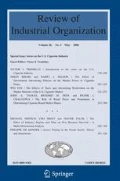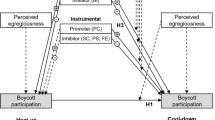Abstract
Modern day antitrust policy is grounded firmly in neoclassical economics. It is important, however, to test whether the modelling assumptions accord with the facts. It is also important to assess whether behavior that deviates from the conventional assumptions is systematic and persistent. If the relevant facts suggest that consumers or firms might behave in ways that depart from conventional assumptions, then private parties, government agencies and the courts should consider alternate economic models that account appropriately for the observed behavior.
Similar content being viewed by others
Notes
Barberis and Thaler (2003) provide an overview of the behavioral finance literature.
The three federal antitrust laws are the Sherman Act of 1890, the Clayton Act of 1914, and the Federal Trade Commission Act of 1914.
A historical overview of how economics has shaped antitrust policy is available in Kovacic and Shapiro (2000).
The Horizontal Merger Guidelines were issued in 1968 (http://www.justice.gov/atr/hmerger/11247.pdf) with revisions issued in 1982, 1992, 1997, and 2010 (http://www.justice.gov/atr/public/guidelines/hmg-2010.html).
In a 2010 interview, two academic economists and former top economic antitrust regulators at the DOJ and FTC commented on behavioral economics and the antitrust agencies’ use of traditional economics models that assume profit maximization to evaluate competitive effects (Roundtable Interview with Joseph Farrell and Carl Shapiro 2010). The former regulators explained the view that while firms may not perfectly profit maximize, the theoretical framework assuming profit maximization remains the best paradigm to use for predicting the competitive effects of a merger. Relatedly, nine academic economists that work in the area of antitrust economics submitted comments during the DOJ and FTC revisions to the horizontal merger guidelines in 2010 stating that they “support the use of the working assumption of profit maximization as the best starting point for competition analysis” (http://www.ftc.gov/sites/default/files/documents/public_comments/horizontal-merger-guidelines-review-project-proposed-new-horizontal-merger-guidelines-548050-00017/548050-00017.pdf at p. 1).
The Lerner Index is an equilibrium relationship that states that a profit-maximizing firm will choose price optimally such that the firm’s percentage mark-up of price over marginal cost is equal to the own-price elasticity of demand faced by the firm. For a single-product firm, the Lerner Index is written as: \( - \frac{1}{{\varepsilon_{d} }} = \frac{{\left( {P - MC} \right)}}{P} \), where ɛ d is the elasticity of demand for the product, \( P \) is the product’s price, and MC is the product’s marginal cost.
The problem arises not in estimating the own-price elasticity of demand econometrically but in deriving the own-price elasticity of demand from an implied relationship with the firm’s gross profit margin.
Malmendier and Tate (2005) show empirically that firms with overconfident CEOs systematically make corporate-level investment decisions that diverge from the optimal.
Kószegi and Rabin (2006) provide a model of reference-based preferences and discuss applications to consumer decision-making.
A number of papers, including Heidhues and Koszegi (2008), Karle and Peitz (2014), and Zhou (2011), provide models of competitive dynamics and equilibrium pricing when consumers are loss averse relative to a reference point, which creates a kink in the firm’s demand curve. Under certain conditions, the kink in the firm’s demand can be either outward or inward.
In the context of financial markets, De Long et al. (1990) show that financial bubbles can persist when there are a sufficient number of irrational noise traders in the market.
Armstrong and Huck (2010) discuss a number of ways in which firm decision-making may depart from standard rational decision-making, such as satisficing behavior, use of rules-of-thumb, and CEO over-optimism.
Huck and Zhou (2011) identify consumer behavioral biases that firms may take advantage of, thereby adversely affecting welfare. See also the model of inattentive consumers in Grubb (2015), which provides conditions under which consumer protection regulations that require firms to disclose hidden fees cause prices to be lower and thereby improve social welfare.
Bubb and Kaufman (2013) identify empirical evidence of systematically different pricing for the credit cards that are offered by investor-owned banks as compared to the credit cards that are offered by credit unions (which are depository institutions that are mutual institutions and thus are owned by their customers).
Sloan (2000) surveys the literature on the behavior of non-profit hospitals compared to for-profit hospitals and provides empirical evidence that is consistent with no systematic difference in the behavior of non-profit hospitals compared to for-profit hospitals.
The business concept of the ‘triple bottom line’, in which a firm’s objective is to strike a balance between people, the planet, and their profits, is one example of such a business strategy.
The case is United States v. Brown University, et al., 5 F. 3d 658 (1993). Bamberger and Carlton (1999) provide a discussion of the litigation in its entirety.
Viscusi et al. (2005, pp. 134–149) provide a discussion of the social welfare loss from a per se violation using the standard economic framework and assumptions.
The district court ruled in favor of the DOJ. However, on appeal to the Third Circuit Court of Appeals, the appeals court ruled in favor of MIT and remanded the case back to the District Court for a re-trial.
In 1994, MIT and the DOJ entered into a settlement agreement rather than continuing to a retrial.
The case is FTC v. Butterworth Health Corp., 946 F. Supp. 1285 (W.D. Mich. Sept. 26, 1996).
See the district court decision in FTC v. Butterworth Health Corp., 946 F. Supp. 1285 (W.D. Mich. Sept. 26, 1996) at 1298 and 1302.
Ibid at 1302.
See Statement of Chairman Timothy J. Muris in the Matter of Genzyme Corporation/Novazyme Pharmaceuticals, Inc., FTC File No. 021-0026 (2004) (http://www.ftc.gov/opa/2004/01/genzyme.shtm).
Ibid at 15.
See In Re Payment Card Interchange Fee and Merchant Discount Antitrust Litigation, MDL No. 1720, Case No. 1:05-md-1720-JG-JO in the United States District Court Eastern District of New York.
The court appointed independent economic expert in this matter, Alan Sykes, provides a discussion of the economic issues as related to settlement of the litigation (https://www.competitionpolicyinternational.com/assets/Uploads/opinion.pdf).
References
Armstrong, M., & Huck, S. (2010). Behavioral economics as applied to firms: A primer. Competition Policy International, 6(1), 2–45.
Bailey, E. (2010). Behavioral economics: Implications for antitrust practitioners. Antitrust Source, 9(5), 1–7.
Bailey, E. (2011). Challenging the assumptions of modern economics in merger analysis. NERA economic consulting antitrust insights. Retrieved from http://www.nera.com/publications/newsletters-briefs/antitrust-insights.html.
Bamberger, G., & Carlton, D. (1999). Antitrust and higher education: MIT financial aid (1993). In J. Kwoka & L. White (Eds.), The antitrust revolution: Economics, competition and policy (pp. 264–285). New York: Oxford University Press.
Barberis, N., & Thaler, R. (2003). A survey of behavioral finance. In G. Constantinides, M. Harris, & R. Stulz (Eds.), Handbook of the economics of finance (pp. 1053–1128). Amsterdam: Elsevier Science.
Bubb, R., & Kaufman, A. (2013). Consumer biases and mutual ownership. Journal of Public Economics., 105, 39–57.
Camerer, C., Issacharoff, S., Loewenstein, G., O’Donoghue, T., & Rabin, M. (2003). Regulation for conservatives: Behavioral economics and the case for ‘asymmetric paternalism’. University of Pennsylvania Law Review, 151, 1211–1254.
De Long, J. B., Shleifer, A., Summers, L., & Waldmann, R. (1990). Noise trader risk in financial markets. Journal of Political Economy, 98(4), 703–738.
Ellison, G. (2006). Bounded rationality in industrial organization. In R. Blundell, W. Newey, & T. Persson (Eds.), Advances in economics and econometrics: Theory and applications, ninth world congress (Vol. II, pp. 142–174). Cambridge: Cambridge University Press.
Farrell, J., Pappalardo, J., & Shelanski, H. (2010). Economics at the FTC: Mergers, dominant-firm conduct, and consumer behavior. Review of Industrial Organization, 37(4), 263–277.
Grubb, M. D. (2015). Consumer inattention and bill-shock regulation. The Review of Economic Studies, 82(1), 219–257.
Heidhues, P., & Kószegi, B. (2008). Competition and price variation when consumers are loss averse. American Economic Review, 98(4), 1245–1268.
Heyer, K., & Shapiro, C. (2010). The year in review: Economics at the antitrust division, 2009–2010. Review of Industrial Organization, 37, 291–307.
Huck, S., & Zhou, J. (2011). Consumer behavioural biases in competition: A survey. Report commissioned by the U.K. Office of fair trading. Retrieved from http://londoneconomics.co.uk/wp-content/uploads/2012/06/Consumer-behavioural-biases-in-competition-OFT1.pdf.
Karle, H., & Peitz, M. (2014). Competition under consumer loss aversion. Rand Journal of Economics, 45(1), 1–31.
Kószegi, R., & Rabin, M. (2006). A model of reference-based preferences. The Quarterly Journal of Economics, 121(4), 1133–1165.
Kovacic, W., & Shapiro, C. (2000). Antitrust policy: A century of economic and legal thinking. Journal of Economic Perspectives, 14(1), 43–60.
Malmendier, U., & Tate, G. (2005). CEO overconfidence and corporate investment. Journal of Finance, 60(6), 2661–2700.
Roundtable Interview with Joseph Farrell and Carl Shapiro. (2010). The antitrust source, 9(3), 1–9.
Salop, S. (2006). Exclusionary conduct, effect on consumers, and the flawed profit-sacrifice standard. Antitrust Law Journal, 73, 311–374.
Sloan, F. (2000). Not for profit ownership and hospital behavior. In A. J. Culyer & J. P. Newhouse (Eds.), Handbook of health economics (Vol. 1, pp. 1141–1174). Amsterdam: Elsevier Science.
Spiegler, R. (2011). Bounded rationality and industrial organization. New York: Oxford University Press.
Tremblay, V. J., & Tremblay, C. H. (2012). New perspectives on industrial organization: With contributions from behavioral economics and game theory. New York: Springer Publishing.
Viscusi, K., Vernon, J., & Harrington, J. (2005). Economics of regulation and antitrust. Cambridge, MA: MIT Press.
Werden, G. (2006). The ‘no economic sense’ test for exclusionary conduct. Journal of Corporation Law., 31, 293–305.
Zhou, J. (2011). Reference dependence and market competition. Journal of Economic and Management Strategy, 20(4), 1073–1094.
Author information
Authors and Affiliations
Corresponding author
Rights and permissions
About this article
Cite this article
Bailey, E.M. Behavioral Economics and U.S. Antitrust Policy. Rev Ind Organ 47, 355–366 (2015). https://doi.org/10.1007/s11151-015-9469-9
Published:
Issue Date:
DOI: https://doi.org/10.1007/s11151-015-9469-9




